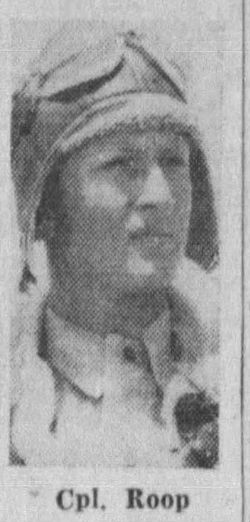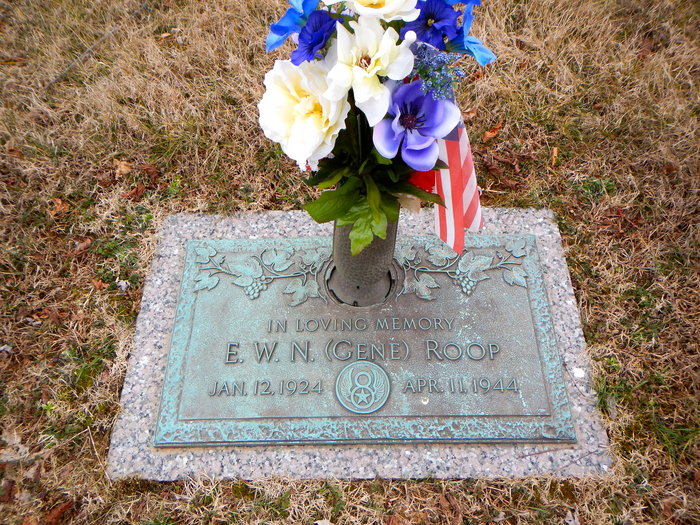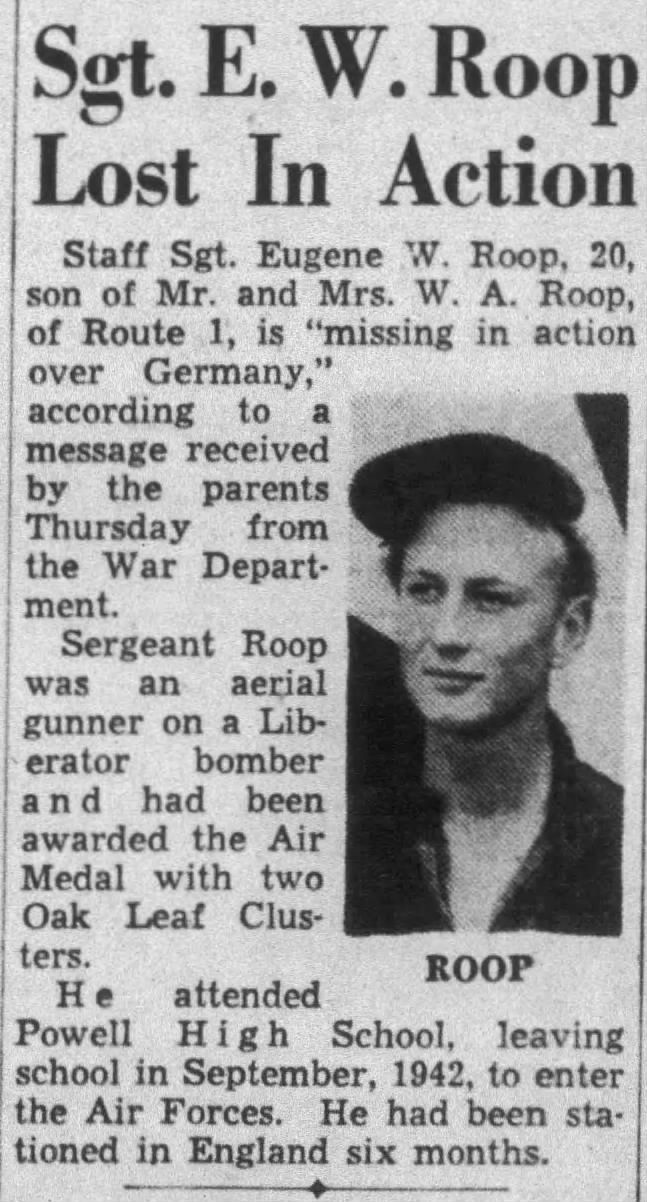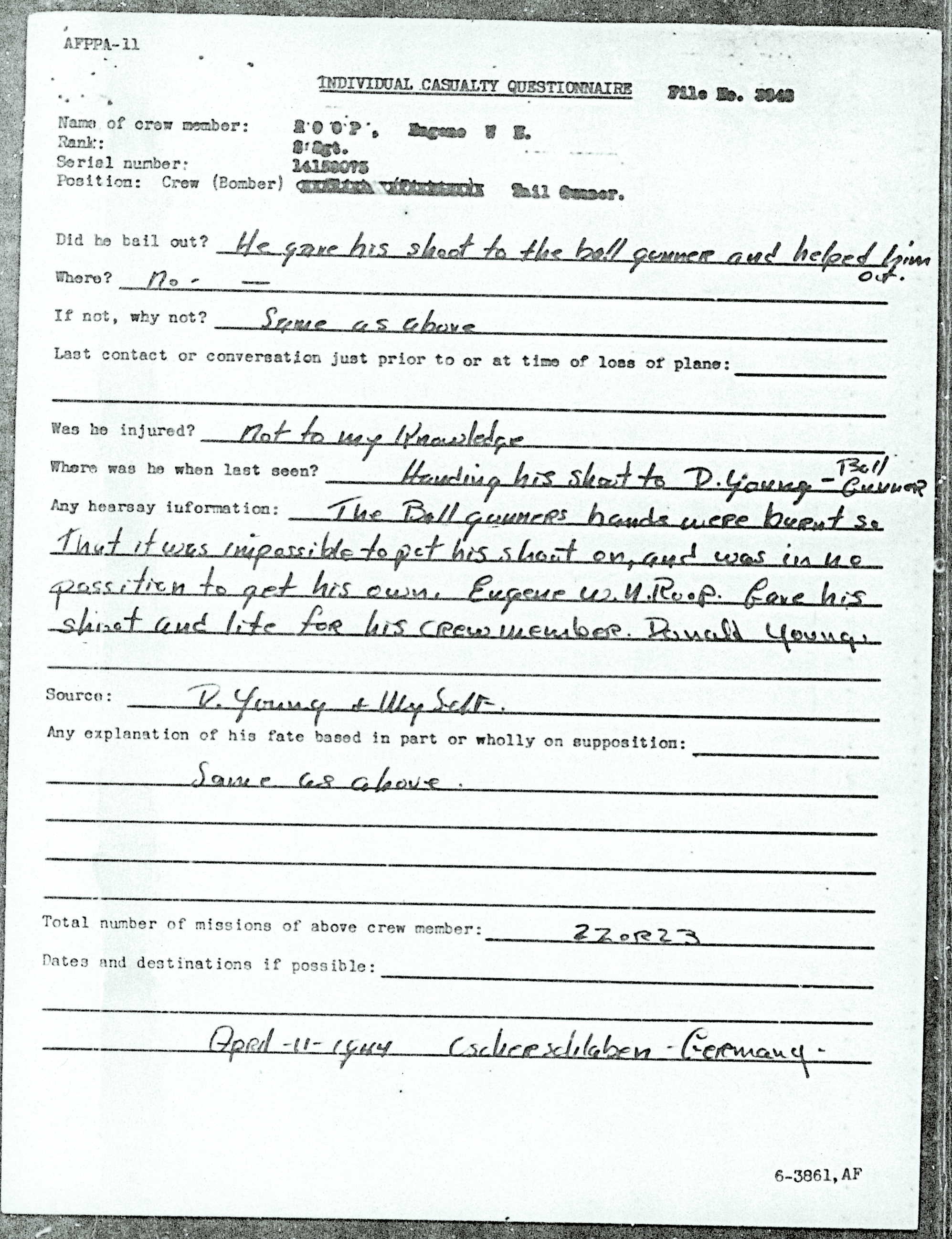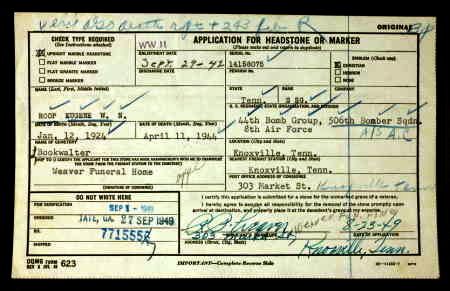-Parents: W. V. and Edith Roop
-506th Bomber Squadron, 44th Bomb Group, 14th BCW, 2nd Air Division, 8th AAF
-Tail Turret Gunner on the B-24 (H) #42-7522, "Southern Comfort II"
-On April 11, 1944 the Southern Comfort II crashed 2 kilometers north of Bernbug, Germany. The 506th Bomber Squadron's specific target was the Junker Aircraft Assembly Plant, which was bombed with good results.
-Roop was stationed in RAF Shipdham in Norfolk, England. RAF Shipdham, in Norfolk, opened in September 1942, was known as Station 115. It became home to the USAAF 44th Bomb Group, 'The Flying Eightballs' equipped with B-24s. The 44th flew 344 missions and lost 153 aircraft, the highest of all the B-24 units. After the war the airfield was used for a short time as a repatriation center for German POWs returning to Germany from the USA. The land was returned to agricultural use with private flying taking place from 1970 onwards. Most of the buildings remain in various states of decay, including the station headquarters close to the entrance, the control tower, MT sheds (motor transport), bomb store. The three original T.2 type Hangers are in use as warehouses. Part of the site is in use as an industrial estate. Several huts remain at the dispersal site to the southeast (506th B.S.), there are two buildings remaining on the communal site, and the 14th CBW is almost intact, along with the 464th sub depot site. The land is now privately owned and permission is required to visit the site. A memorial to the 44th Bomb Group was erected in 1983 in the grounds of the parish church All Saints in the nearby village.
-He is buried at Bookwalter Cemetery, Knoxville, TN
From 44th Bomb Group Roll of Honor and Casualties. By Will Lundy
***
11 APRIL 1944. BERNBERG GERMANY
For the third straight time fierce enemy opposition from the air as well as from the ground was experienced by our Group. The specific target was the Junkers Aircraft Assembly Plant which was bombed with good results. One aircraft did not return, a 506th plane piloted by Lt John D. Money.
Southern Comfort II, AC #42-7522, B-24H-1.
1st Lt John D. Money, Pilot, POW
1st Lt Robert G. Stamos, Co-Pilot, KIA
1st Lt Harold J. Wheatley, Navigator, KIA
SSgt Foster A. Blake, Nose Turret, KIA
TSgt Andrew C. Graff, Engineer, KIA
TSgt Edward A. Wernicki, Radio Operator, KIA
SSgt Herbert S. Hill Jr., Ball Turret, KIA
SSgt Donald L. Young, RW Gunner, POW
SSgt Wallace E. Kirschner, LW Gunner, POW
SSgt Eugene W.N. Roop, Tail Turret, KIA
The MACR states that the aircraft went down at 11h23. The right bomb bay door failed to open, so when the bombs were dropped, the right side fragmentation bombs hit the closed door, immediately setting that area on fire. The ship flew on for awhile, then winged over, and breaking in two at the waist section. It went down and exploded. Four bodies came clear of the falling wreckage. But only two chutes were seen to open.
Sgt Wallace Kirschner, left waist gunner, sent his experience:
"According to my diary, we had flown nine missions prior to this one on 11 April. We were carrying incendiary bombs. Near the target, we were under a barrage of flak, getting set for our bomb run. The bomb bay doors would not open as the tracks were frozen tight. Upon informing Lt Money, our pilot, that I could not break the ice, we received a direct hit in the bomb bay. The rest is history.
Sgt Roop, tail gunner, saw that Sgt Young's hands were badly burned, took his own parachute and placed it on Sgt Young and helped him get through the rear camera hatch door. This resulted in Sgt Roop being without a parachute of his own. I followed Young out the rear hatch, after removing my oxgen mask, because I couldn't get the hose to release from the regulator. With the mask removed, I got 3rd degree burns on my face and right hand due to the fire all around me.
I was picked up by German soldiers upon landing and was taken to an aid station in Frankfurt. They had converted an Agricultural School into a hospital. The Doctors and aids were all part of the Dunkirk Evacuation Force Captured - who were a wonderful group of men. Then I was sent to Bad Soden for work on my eyes. Even the Doctors there were from Dunkirk. I was later repatriated and returned to the states on 21 February 1945. I saw Sgt Young once after the war."
Lt Money wrote: "When the fire erupted in the bomb bay it quickly spread forward, filling the cabin with fire and smoke. I gave the bail out signal, as my co-pilot, Robert Stamos, was already dead from flak wounds. I then contemplated my own escape from that inferno. There was absolutely no way I could get back to the bomb bay, and the top hatch itself was burning. So it would have to be out one of the windows, but they were still intact. While still trying to maintain some control of the craft, I got my feet up, and braced my back, and succeeded in kicking out the co-pilot's window.
Then I managed to get over Stamos, got hold of his wheel, and continued to hold the plane under control as I worked myself out that window. Soon I was entirely outside the ship, but still holding onto the wheel as I needed to tilt the plane right-wing high, as that #3 prop was still churning the air a very short distance behind me.
Then I let go - immediately got clipped on my head by a tip of one of the propeller blades that knocked me out. But the cold air brought me to my senses before I hit the ground and I got my chute open in time. On the ground I found I was not seriously injured, and soon was taken prisoner.
James H. Stevens was part of Capt. Schmidt's crew K-314. He saw Money's aircraft go down and spotted two chutes. He noted that on this mission his aircraft's nose turret was demolished, one engine was knocked out, and one tail section was shot up, but the aircraft returned safely to Shipham. He wrote that Lew Karstadt in the nose turret was saved by the rather small panel of armored glass. When we all got out of our flight gear at the base later on, we found that Lew had been the only one wounded in the attack. As I recall, it was a flak fragment in his knee."
Rank: Staff Sergeant
**************
(middle name provided by John #47304722)
-Parents: W. V. and Edith Roop
-506th Bomber Squadron, 44th Bomb Group, 14th BCW, 2nd Air Division, 8th AAF
-Tail Turret Gunner on the B-24 (H) #42-7522, "Southern Comfort II"
-On April 11, 1944 the Southern Comfort II crashed 2 kilometers north of Bernbug, Germany. The 506th Bomber Squadron's specific target was the Junker Aircraft Assembly Plant, which was bombed with good results.
-Roop was stationed in RAF Shipdham in Norfolk, England. RAF Shipdham, in Norfolk, opened in September 1942, was known as Station 115. It became home to the USAAF 44th Bomb Group, 'The Flying Eightballs' equipped with B-24s. The 44th flew 344 missions and lost 153 aircraft, the highest of all the B-24 units. After the war the airfield was used for a short time as a repatriation center for German POWs returning to Germany from the USA. The land was returned to agricultural use with private flying taking place from 1970 onwards. Most of the buildings remain in various states of decay, including the station headquarters close to the entrance, the control tower, MT sheds (motor transport), bomb store. The three original T.2 type Hangers are in use as warehouses. Part of the site is in use as an industrial estate. Several huts remain at the dispersal site to the southeast (506th B.S.), there are two buildings remaining on the communal site, and the 14th CBW is almost intact, along with the 464th sub depot site. The land is now privately owned and permission is required to visit the site. A memorial to the 44th Bomb Group was erected in 1983 in the grounds of the parish church All Saints in the nearby village.
-He is buried at Bookwalter Cemetery, Knoxville, TN
From 44th Bomb Group Roll of Honor and Casualties. By Will Lundy
***
11 APRIL 1944. BERNBERG GERMANY
For the third straight time fierce enemy opposition from the air as well as from the ground was experienced by our Group. The specific target was the Junkers Aircraft Assembly Plant which was bombed with good results. One aircraft did not return, a 506th plane piloted by Lt John D. Money.
Southern Comfort II, AC #42-7522, B-24H-1.
1st Lt John D. Money, Pilot, POW
1st Lt Robert G. Stamos, Co-Pilot, KIA
1st Lt Harold J. Wheatley, Navigator, KIA
SSgt Foster A. Blake, Nose Turret, KIA
TSgt Andrew C. Graff, Engineer, KIA
TSgt Edward A. Wernicki, Radio Operator, KIA
SSgt Herbert S. Hill Jr., Ball Turret, KIA
SSgt Donald L. Young, RW Gunner, POW
SSgt Wallace E. Kirschner, LW Gunner, POW
SSgt Eugene W.N. Roop, Tail Turret, KIA
The MACR states that the aircraft went down at 11h23. The right bomb bay door failed to open, so when the bombs were dropped, the right side fragmentation bombs hit the closed door, immediately setting that area on fire. The ship flew on for awhile, then winged over, and breaking in two at the waist section. It went down and exploded. Four bodies came clear of the falling wreckage. But only two chutes were seen to open.
Sgt Wallace Kirschner, left waist gunner, sent his experience:
"According to my diary, we had flown nine missions prior to this one on 11 April. We were carrying incendiary bombs. Near the target, we were under a barrage of flak, getting set for our bomb run. The bomb bay doors would not open as the tracks were frozen tight. Upon informing Lt Money, our pilot, that I could not break the ice, we received a direct hit in the bomb bay. The rest is history.
Sgt Roop, tail gunner, saw that Sgt Young's hands were badly burned, took his own parachute and placed it on Sgt Young and helped him get through the rear camera hatch door. This resulted in Sgt Roop being without a parachute of his own. I followed Young out the rear hatch, after removing my oxgen mask, because I couldn't get the hose to release from the regulator. With the mask removed, I got 3rd degree burns on my face and right hand due to the fire all around me.
I was picked up by German soldiers upon landing and was taken to an aid station in Frankfurt. They had converted an Agricultural School into a hospital. The Doctors and aids were all part of the Dunkirk Evacuation Force Captured - who were a wonderful group of men. Then I was sent to Bad Soden for work on my eyes. Even the Doctors there were from Dunkirk. I was later repatriated and returned to the states on 21 February 1945. I saw Sgt Young once after the war."
Lt Money wrote: "When the fire erupted in the bomb bay it quickly spread forward, filling the cabin with fire and smoke. I gave the bail out signal, as my co-pilot, Robert Stamos, was already dead from flak wounds. I then contemplated my own escape from that inferno. There was absolutely no way I could get back to the bomb bay, and the top hatch itself was burning. So it would have to be out one of the windows, but they were still intact. While still trying to maintain some control of the craft, I got my feet up, and braced my back, and succeeded in kicking out the co-pilot's window.
Then I managed to get over Stamos, got hold of his wheel, and continued to hold the plane under control as I worked myself out that window. Soon I was entirely outside the ship, but still holding onto the wheel as I needed to tilt the plane right-wing high, as that #3 prop was still churning the air a very short distance behind me.
Then I let go - immediately got clipped on my head by a tip of one of the propeller blades that knocked me out. But the cold air brought me to my senses before I hit the ground and I got my chute open in time. On the ground I found I was not seriously injured, and soon was taken prisoner.
James H. Stevens was part of Capt. Schmidt's crew K-314. He saw Money's aircraft go down and spotted two chutes. He noted that on this mission his aircraft's nose turret was demolished, one engine was knocked out, and one tail section was shot up, but the aircraft returned safely to Shipham. He wrote that Lew Karstadt in the nose turret was saved by the rather small panel of armored glass. When we all got out of our flight gear at the base later on, we found that Lew had been the only one wounded in the attack. As I recall, it was a flak fragment in his knee."
Rank: Staff Sergeant
**************
(middle name provided by John #47304722)
Family Members
Sponsored by Ancestry
Advertisement
Advertisement
